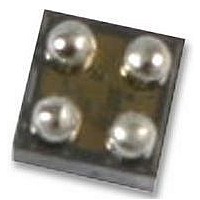LP3990TL-1.5 National Semiconductor, LP3990TL-1.5 Datasheet - Page 10

LP3990TL-1.5
Manufacturer Part Number
LP3990TL-1.5
Description
IC, V REG LDO 0.15A 1.5V, SMD, 3990
Manufacturer
National Semiconductor
Datasheet
1.LP3990TL-1.2.pdf
(13 pages)
Specifications of LP3990TL-1.5
Primary Input Voltage
2.5V
Output Voltage
1.5V
Dropout Voltage Vdo
60mV
No. Of Pins
4
Output Current
150mA
Operating Temperature Range
-40°C To +125°C
Svhc
No SVHC (15-Dec-2010)
Operating
RoHS Compliant
Output Voltage Fixed
1.5V
Voltage Regulator Case Style
Micro SMD
Rohs Compliant
Yes
Available stocks
Company
Part Number
Manufacturer
Quantity
Price
Company:
Part Number:
LP3990TL-1.5/NOPB
Manufacturer:
National Semiconductor
Quantity:
1 844
Company:
Part Number:
LP3990TL-1.5/NOPB
Manufacturer:
Texas Instruments
Quantity:
10 000
www.national.com
Application Hints
EXTERNAL CAPACITORS
In common with most regulators, the LP3990 requires exter-
nal capacitors for regulator stability. The LP3990 is specifi-
cally designed for portable applications requiring minimum
board space and smallest components. These capacitors
must be correctly selected for good performance.
INPUT CAPACITOR
An input capacitor is required for stability. It is recommended
that a 1.0µF capacitor be connected between the LP3990
input pin and ground (this capacitance value may be in-
creased without limit).
This capacitor must be located a distance of not more than
1cm from the input pin and returned to a clean analogue
ground. Any good quality ceramic, tantalum, or film capacitor
may be used at the input.
Important: To ensure stable operation it is essential that
good PCB design practices are employed to minimize
ground impedance and keep input inductance low. If these
conditions cannot be met, or if long leads are used to con-
nect the battery or other power sorce to the LP3990, then it
is recommended to increase the input capacitor to at least
2.2µF. Also, tantalum capacitors can suffer catastrophic fail-
ures due to surge current when connected to a low-
impedance source of power (like a battery or a very large
capacitor). If a tantalum capacitor is used at the input, it must
be guaranteed by the manufacturer to have a surge current
rating sufficient for the application.
There are no requirements for the ESR (Equivalent Series
Resistance) on the input capacitor, but tolerance and tem-
perature coefficient must be considered when selecting the
capacitor to ensure the capacitance will remain approxi-
mately 1.0µF over the entire operating temperature range.
OUTPUT CAPACITOR
The LP3990 is designed specifically to work with very small
ceramic output capacitors. A 1.0µF ceramic capacitor (tem-
perature types Z5U, Y5V or X7R) with ESR between 5mΩ to
500mΩ, is suitable in the LP3990 application circuit.
For this device the output capacitor should be connected
between the V
It is also possible to use tantalum or film capacitors at the
device output, C
tive for reasons of size and cost (see the section Capacitor
Characteristics).
The output capacitor must meet the requirement for the
minimum value of capacitance and also have an ESR value
that is within the range 5mΩ to 500mΩ for stability.
NO-LOAD STABILITY
The LP3990 will remain stable and in regulation with no
external load. This is an important consideration in some
circuits, for example CMOS RAM keep-alive applications.
CAPACITOR CHARACTERISTICS
The LP3990 is designed to work with ceramic capacitors on
the output to take advantage of the benefits they offer. For
capacitance values in the range of 0.47µF to 4.7µF, ceramic
capacitors are the smallest, least expensive and have the
lowest ESR values, thus making them best for eliminating
OUT
OUT
pin and ground.
(or V
OUT
), but these are not as attrac-
10
high frequency noise. The ESR of a typical 1.0µF ceramic
capacitor is in the range of 20mΩ to 40mΩ, which easily
meets the ESR requirement for stability for the LP3990.
For both input and output capacitors, careful interpretation of
the capacitor specification is required to ensure correct de-
vice operation. The capacitor value can change greatly, de-
pending on the operating conditions and capacitor type.
In particular, the output capacitor selection should take ac-
count of all the capacitor parameters, to ensure that the
specification is met within the application. The capacitance
can vary with DC bias conditions as well as temperature and
frequency of operation. Capacitor values will also show
some decrease over time due to aging. The capacitor pa-
rameters are also dependant on the particular case size,
with smaller sizes giving poorer performance figures in gen-
eral. As an example, Figure 1 shows a typical graph com-
paring different capacitor case sizes in a Capacitance vs. DC
Bias plot. As shown in the graph, increasing the DC Bias
condition can result in the capacitance value falling below
the minimum value given in the recommended capacitor
specifications table (0.7µF in this case). Note that the graph
shows the capacitance out of spec for the 0402 case size
capacitor at higher bias voltages. It is therefore recom-
mended that the capacitor manufacturers’ specifications for
the nominal value capacitor are consulted for all conditions,
as some capacitor sizes (e.g. 0402) may not be suitable in
the actual application.
The ceramic capacitor’s capacitance can vary with tempera-
ture. The capacitor type X7R, which operates over a tem-
perature range of -55˚C to +125˚C, will only vary the capaci-
tance to within
tolerance over a reduced temperature range of -55˚C to
+85˚C. Many large value ceramic capacitors, larger than 1µF
are manufactured with Z5U or Y5V temperature characteris-
tics. Their capacitance can drop by more than 50% as the
temperature varies from 25˚C to 85˚C. Therefore X7R is
recommended over Z5U and Y5V in applications where the
ambient temperature will change significantly above or be-
low 25˚C.
Tantalum capacitors are less desirable than ceramic for use
as output capacitors because they are more expensive when
comparing equivalent capacitance and voltage ratings in the
0.47µF to 4.7µF range.
FIGURE 1. Graph Showing a Typical Variation in
±
15%. The capacitor type X5R has a similar
Capacitance vs DC Bias
20076840













